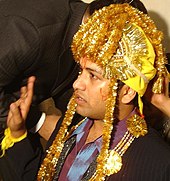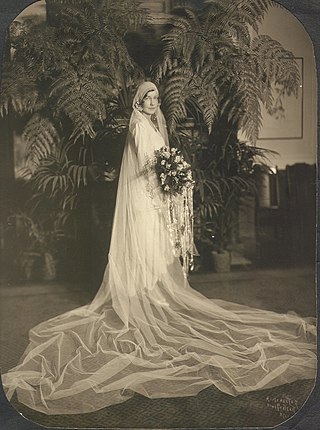
A bride is a woman who is about to be married or who is a newlywed.

Baraat or Varayatra is a groom's wedding procession in Indian subcontinent. In Indian subcontinent, it is customary for the bridegroom to travel to the wedding venue on a mare, accompanied by his family members.

A Sehra or Sehro or Mundavalya or Morrah or Basikam is a forehead garland/nuptial crown worn by the bridegroom during weddings in Indian subcontinent. This decorative groom’s veil can be made either out of flowers or beads and is tied to the groom’s turban or Pagdi.
A Hindu wedding, also known as Vivaha, Marathi: Lagna (लग्न), Bengali: Bibaho (বিবাহ), Kalyanam, Kannada script: ಮದುವೆ (Maduve), Tamil: திருமணம் (Tirumanam), or Pelli, is the traditional wedding ceremony for Hindus. The wedding ceremonies are very colourful, and celebrations may extend for several days and usually a large number of people attend the wedding functions. The bride's and groom's home—entrance, doors, wall, floor, roof—are sometimes decorated with colors, flowers, and other decorations.

Wedding photography is a specialty in photography that is primarily focused on the photography of events and activities relating to weddings. It may include other types of portrait photography of the couple before the official wedding day, such as a pre-wedding engagement session, in which the photographs are later used for the couple's wedding invitations. On the wedding day, the photographer(s) will provide portrait photography as well as documentary photography to document the different wedding events and rituals throughout the day(s).

Anand Karaj is the Sikh marriage ceremony, meaning "Act towards happiness" or "Act towards happy life", that was introduced by Guru Amar Das. The four laavaan were composed by his successor, Guru Ram Das. Although the recitation of Guru Amar Das' stanzas in Sikh ceremonies is a historical and enduring tradition, the practice of circumabulating around the Guru Granth Sahib to conduct a marriage ceremony is a relatively recent innovation that supplanted the tradition of circumabulating around the sacred fire (havan) in the early twentieth century. The Anand ceremony was originally legalised in India through the passage of the Anand Marriage Act of 1909, but is now governed by the Sikh Reht Maryada that was issued by the Shiromani Gurdwara Prabandhak Committee (SGPC).

A Bengali Muslim wedding is a Bengali wedding in accordance to Muslim faith.

An Ayyavazhi wedding is the wedding custom within the Ayyavazhi belief system of South India. Usually Dharmagharttas, Panividaiyalars from Thangals or an older person experienced in Ayyavazhi assumes a role as a Guru and is seated in the Manvarai for leading the wedding ceremony.
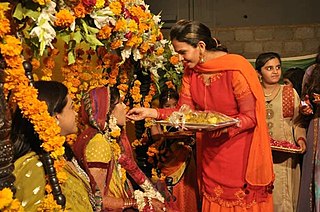
Marriage in Pakistan pertains to wedding traditions established and adhered by Pakistani men and women. Despite their local and regional variations, marriages in Pakistan generally follow Islamic marital jurisprudence. Marriages are not only seen as a union between a husband and a wife, but also an alliance between their respective families. These traditions extend to other countries around in the world where Overseas Pakistani communities exist.
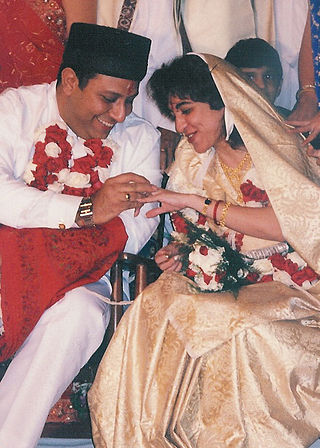
A Zoroastrian wedding is a religious ceremony in Zoroastrianism in which two individuals, a man and a woman, are united. In Zoroastrianism, marriage within the community is encouraged, and is greatly favored in religious texts. The following information will detail ceremony procedures and traditional processes for a Zoroastrian wedding.

Mayian, also known as Maiyun, Haldi, or Ubtan, is the term used for the preparation ceremony one day before Punjabi weddings of India and Pakistan. This ceremony is a late afternoon or early evening festival, at the couple's parental homes. It consists of many rites, including the Batna, Choora, Jaggo, fireworks and sometimes the ladies Sangeet and mehndi. In South Indian weddings a similar ceremony takes place called the "Pithi" ceremony.

Choora or Chuda or Chudlo is a set of bangles traditionally worn by a bride on her wedding day and for a period after, especially in Indian weddings.
Ukrainian wedding is the traditional marriage ceremony in Ukrainian culture, both in Ukraine and in the Ukrainian diaspora. The traditional Ukrainian wedding featured a rich assortment of folk music and singing, dancing, and visual art, with rituals dating back to the pre-Christian era. Over time, the ancient pagan traditions and symbols were integrated into Christian ones.
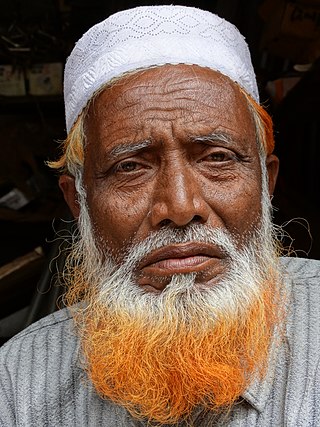
Henna is a reddish dye prepared from the dried and powdered leaves of the henna tree. It has been used since at least the ancient Egyptian period as a hair and body dye, notably in the temporary body art of mehndi resulting from the staining of the skin using dyes from the henna plant. After henna stains reach their peak colour, they hold for a few days, then gradually wear off by way of exfoliation, typically within one to three weeks.
Hindi wedding songs are a major genre of Hindi film music. They often form the backdrop of some very memorable emotional or joyful scenes in Hindi movies. They are often played during Indian, and other South Asian weddings.

Muslim marriage and Islamic wedding customs are traditions and practices that relate to wedding ceremonies and marriage rituals prevailing within the Muslim world. Although Islamic marriage customs and relations vary depending on country of origin and government regulations, both Muslim men and women from around the world are guided by Islamic laws and practices specified in the Quran. Islamic marital jurisprudence allows Muslim men to be married to multiple women.
Bahaghara is a wedding ceremony performed by Odia Hindu people in the Indian state of Odisha. There are subtle differences in the rites observed by different castes. In Odia marriage rituals, the mother of the bridegroom does not take part in the ceremony. The Utkala Brahmins have their weddings only in the daytime, preferably at midday or in the morning, while the other caste weddings are done during the evening or night. There is the custom of sending betel nuts to family friends for inviting them to the marriage. The first invitation is sent to the family deity as a respect to the lord. Marriages in Odisha are mostly fixed and arranged by the parents. Marriages for serving or capturing is not common.

Traditional Hajong marriage is a ceremonial ritual that involves a marriage established by pre-arrangement between families. Within Hajong culture, romantic love and widow re-marriage was allowed, and monogamy was the norm for the Hajong people.
Sindhi traditions and rituals refers to the traditions and rituals practiced by the Sindhis, the cultural group native to Sindh, Pakistan. have many traditions and rituals starting from the birth of a child to the death of a person. These traditions and rituals differ from region to region and also from one religion to another.









